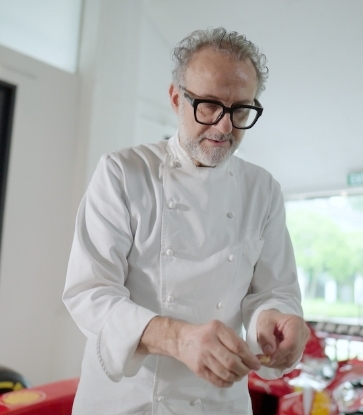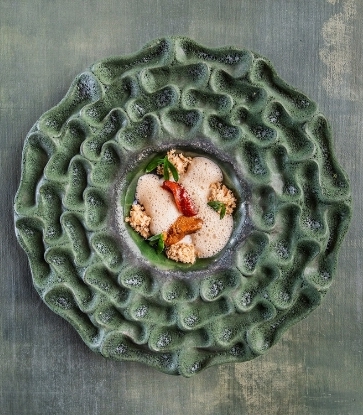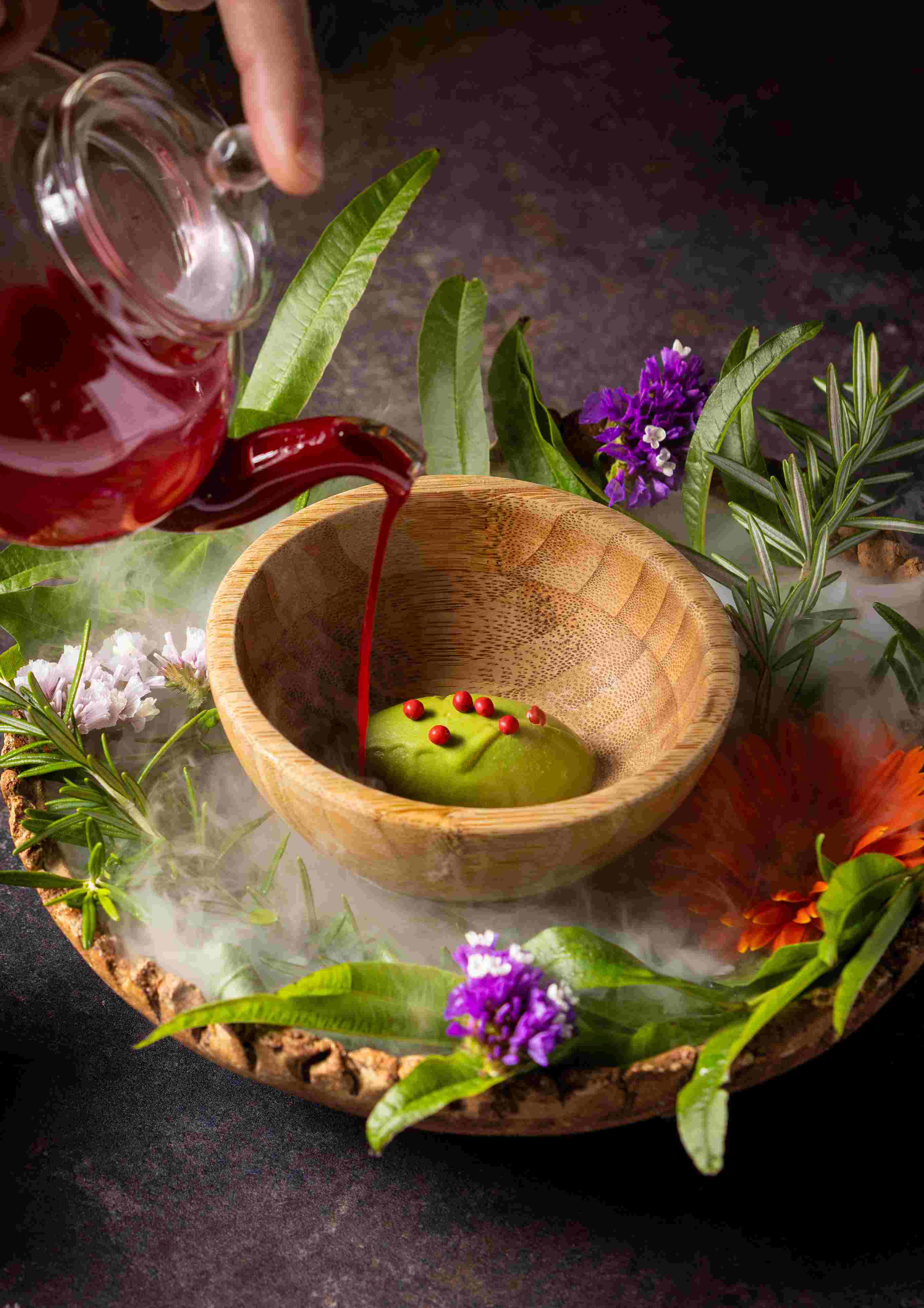Jeremy Ford is charismatic and high energy, with a booming voice and an electric personality that he channels into his culinary endeavors. He began his career in the kitchens of celebrated chefs like Jean-Georges Vongerichten and Dean Max, but it was his win on season 13 of TV’s Top Chef that catapulted him to fame and spurred a partnership with Grove Bay Hospitality, a Miami-based restaurant group, to debut his flagship restaurant, One MICHELIN Star Stubborn Seed, in 2017. Its tasting menu format offers elevated dishes in an unpretentious setting where Ford is seen in his signature black cap, t-shirt, apron, and tattoos, presiding over the bustling kitchen through a massive glass window facing the dining room.
In 2021, Ford expanded his reach to Palm Beach to open The Butcher’s Club at the PGA National Resort, and he recently announced that he and Grove Bay Hospitality will be opening a second Stubborn Seed in Las Vegas later this year at Resorts World Las Vegas. Now, Ford can also add farmer to his resume, as he recently bought a six-acre property in South Miami’s agricultural district known as the Redlands. He has big plans for the swath of land, including cultivating crops for his restaurant and hosting special farm to table dinners.
We checked in with him to see how farming has changed his perspective and how he manages to fit it all into his day.
What’s a typical morning like for you?
I live in Palmetto Bay which is about 35 minutes from the farm. Three mornings a week I wake up at 5:30 a.m. to make it to my jiu jitsu class at 6 and from there go straight to the farm. I get to the farm by 7:30, which is still late for a farmer. It’s already so hot by then—the sun is up, and humidity is in full effect. We have a three-bedroom house on the farm, so I have one of my kitchen crew living there and helping take care of the farm. We made a cold plunge on the farm using—nothing fancy—we use trash cans from Home Depot. We started at 90 seconds and now we’re up to seven minutes, so we do that right after I arrive. Then we set up a plan for the day—what needs to be planted, what needs to be transplanted to bigger pots. There’s always lots to clean up—weeding, tree shedding, etc.
Give us the lay of the land.
The property was owned by a horticulturist and she planted a bunch of valuable and beautiful native trees. There are also these exotic plants like the ylang ylang flower growing — it’s used in Chanel perfume—and we’re playing around with it in our cocktail program. We’re adding a 7,000-square-foot space where we can have farm dinners, host cooking classes, and have charity dinners, so we have construction going on. I’ve spent $100,000 on concrete to make the dining pavilion solid and strong. It’s an open-air pavilion with the goal eventually to close it up because I want to do an upscale farm event space where we’ll have air conditioning and women can wear heels. I’m thinking more about the hospitality aspect of these farm to table dinners. I guess I’m not thinking like a farmer in that sense. I want to have that extra layer of comfort. You’re getting really bad-ass farm ingredients but it will be in an environment that’s super comfortable with a real bartender mixing you a cocktail.



How’s the growing going so far?
We’re doing everything organic—and the pests are a disaster—aphids, white flies, peacocks. Everything wants to attack the plants. I wasn’t raised on a farm and I have zero knowledge but I started researching what to do and it’s a lot of soaps and mixes with cayenne pepper and you actually have to spray it at the right time—like on the night of the full moon because all the caterpillars lay their eggs on that night. I didn’t know that on our first full moon and I lost $1,000 in plants.
What have you grown this season?
We’ve got heirloom carrots, baby fennel, radishes, broccoli rabe, Hakurei turnips, and tomatillos. We’re doing 120-foot-long rows of raised beds. We’re growing all in pots and trays, but next year we’re going to be in the ground. The soil is rich so I’m excited to see what we get from that. For me to grow this variety of crops is super complicated, because they all need different nutrients but we’re figuring it out. A really cool thing is Dan Barber (chef and co-owner of Blue Hill at Stone Barns) sent us his Row 7 seeds as a gift, which was so special. I'm hoping to have him come down at some point for a dinner.


What’s an ingredient from the farm that you have incorporated onto the menu at the restaurant?
We grow Everglades tomatoes on the farm. They grow wild in South Florida and it’s the craziest flavor bomb tomato I’ve ever had. They’re small, like half a teardrop tomato and so tasty. We’re doing a dish at the restaurant where it’s an amuse bouche of that tomato three ways: we make a gelee veil out of the juice, underneath it is some raw tomatoes tossed with a Thai chili vinaigrette, and on the plate is a smoked tomato gel.
We’ve always been ingredient-driven, but it’s all going to change once we’re harvesting. It's not like a vegetable purveyor where you can put in an order—it’s here’s what we have and now let’s work with it, so it puts more of a challenge on the kitchen.
Have you been cooking on the farm?
Even on a typical day working on the farm we make it a priority to have good lunches. We gather together whatever herbs we have, like Thai basil and some tomatoes, and I’ll bring a steak, and we’ll grill for lunch. I always want to maintain that, to always have a solid meal on the farm every day.
But you have to make it back to the restaurant at some point, right?
Some days I stay until 6 p.m. but most days I split my time between the farm and the restaurant. I absolutely have to set my alarm to about 1:30 p.m.; otherwise I get distracted by all the tasks and the hours go by, but I need to make it up to the restaurant by 3 p.m. When I get to the restaurant, I always bring a cooler of whatever I’ve harvested from the farm. The way we care for these veggies is elaborate—we wash all the vegetables, shock them in ice water, and store them in linen. It’s literally our blood, sweat, and tears right there on the plate.

All images courtesy of Stubborn Seed





















